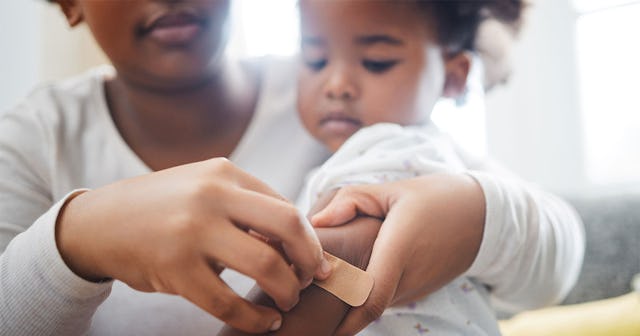First Aid Is Too Important To Ignore — Here's What Belongs In A First Aid Kit

If there’s one thing a home with kids living in it needs, it’s a well-stocked first aid kit. I don’t know if my kids are the exception or the rule, but it seems like all they do is invent ways to scrape, scratch, bump, burn and blister themselves. My middle child once sliced his little finger open on a blade of grass. I kid you not.
I usually default to buying those pre-made first aid kits that are widely available at pharmacies and big box stores. Of course, with kids the band-aids, antibiotic ointment, gauze and tape disappear first, and I buy another set around the time when I end up with just a plastic box with a foil blanket and a glow stick left in it. I have never been awesome at restocking my kits, and honestly, I realized recently that I wasn’t too terribly certain that the pre-made sets were even the way to go.
First aid is too important to wing it, so I am committed to doing way better. I’ve been doing a little online digging, and I think I’ve determined what a household should really keep on hand for all their first aid needs. Here’s what I’ve learned.
First of all, those pre-made first aid kits are actually totally fine!
Turns out, I’ve been doing fine! For your home, business and vehicles, The American Red Cross sells a variety of pre-packaged kits that should cover most simple first aid needs. If you want to create your own kit instead, the American Red Cross recommends the following items:
- 2 absorbent compress dressings (5 x 9 inches)
- 25 adhesive bandages (assorted sizes)
- 1 adhesive cloth tape (10 yards x 1 inch)
- 5 antibiotic ointment packets (approximately 1 gram)
- 5 antiseptic wipe packets
- 2 packets of aspirin (81 mg each)
- 1 emergency blanket
- 1 breathing barrier (with one-way valve)
- Instant cold compress
- 2 pair of non-latex gloves (size: large)
- 2 hydrocortisone ointment packets (approximately 1 gram each)
- 1 3 in. gauze roll (roller) bandage
- 1 roller bandage (4 inches wide)
- 5 3 in. x 3 in. sterile gauze pads
- 5 sterile gauze pads (4 x 4 inches)
- Oral thermometer (non-mercury/non-glass)
- 2 triangular bandages
- Tweezers
- Emergency First Aid guide
Each household should have multiple first aid kits.
This is where I’ve been dropping the ball. I always keep some band-aids in my purse, but my van’s first aid kid has occasionally been a bottle of water and a fast-food napkin. I’ll be fixing that ASAP!
Ideally, you should have one first aid kit for the home and one for each family vehicle, as well as a smaller one to throw in your purse, diaper bag or backpack. The kits for your bag can be very simple. Some bandages, antiseptic wipes, antibiotic ointment and some ibuprofen and acetaminophen (both adult and children’s) should be sufficient for the occasional scrape, scratch or headache. Your vehicle kit will cover the rest.
Don’t forget to replace things as you use them up, or when they expire!
Pre-made first aid kits are helpful starting points, but you’ll need to stay on top of restocking them if you want them to remain effective.
Most things in your kit will eventually expire. For example, Band-Aid brand bandages don’t typically expire, but some Band-Aid brand products with antiseptic properties do. Most creams and ointments expire, and even mylar blankets are only meant to last a year or two. Keep an eye on those dates so that your first aid kit remains truly helpful, and it doesn’t just provide a false sense of preparedness.
In addition to creating or purchasing a well-stocked basic first aid kit, you’ll need to do a few more things to make sure you’re ready for first aid emergencies.
Compile a list for every member of your household that includes their basic stats, like age, body weight and medical conditions. Make sure you include every medication that they take on a regular basis, including supplements and over-the-counter drugs, as well as dosages.
Include a list of contact information for every healthcare provider you see. Include their address and the name of the practice.
Teach your children how to dial 911 and how to put the phone on speaker so they can lay it down and continue to receive instructions in case you’re the one that needs assistance.
You might also consider purchasing a LifeVac, a choking rescue device that has saved hundreds of lives since its invention.
You can’t avoid all minor injuries and accidents, but being prepared with a well-stocked first aid kit can be the difference between a ten-minute patch-up job and a disrupted day with an hour-long errand to the nearest drug store.
This article was originally published on